同济大学:《中国社会经济》课程教学资源(PPT课件讲稿)Demographic Transition in China

Social Economic Development China Today "当代中国"集列课程 Demographic Transition in China
Understanding a Development Miracle Demographic Transition in China Social Economic Development

0.09。●9。09●●09●●●●0●。09●●●0●●●●●●●●●0●●●0●●000g China has a huge population,but a weak economic foundation with relatively inadequate resources per capita.These are its basic national conditions.Many contradictions and problems in : China's economic and social development are closely associated with the issue of population,which has become the key factor and primary problem restricting China's economic and social development. what should we pay attention to when we discuss the population: and economic growth in China?
China has a huge population, but a weak economic foundation with relatively inadequate resources per capita. These are its basic national conditions. Many contradictions and problems in China's economic and social development are closely associated with the issue of population, which has become the key factor and primary problem restricting China's economic and social development. what should we pay attention to when we discuss the population and economic growth in China?
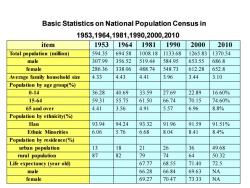
Basic Statistics on National Population Census in 1953,1964,1981,1990,2000,2010 item 1953 1964 1981 1990 2000 2010 Total population (million) 594.35 694.58 1008.18 1133.68 1265.83 1370.54 male 307.99 356.52 519.44 584.95 653.55 686.8 female 286.36 338.06 488.74 548.73 612.28 652.8 Average family household size 4.33 4.43 4.41 3.96 3.44 3.10 Population by age group(%) 0-14 36.28 40.69 33.59 27.69 22.89 16.60% 15-64 59.31 55.75 61.50 66.74 70.15 74.60% 65 and over 4.41 3.56 4.91 5.57 6.96 8.8% Population by ethnicity(%) Han 93.94 94.24 93.32 91.96 91.59 91.51% Ethnic Minorities 6.06 5.76 6.68 8.04 8.41 8.4% Population by residence(%) urban population 13 18 21 26 36 49.68 rural population 87 82 79 74 64 50.32 Life expectancy (year old) 67.77 68.55 71.40 72.5 male 66.28 66.84 69.63 NA female 69.27 70.47 73.33 NA
Basic Statistics on National Population Census in 1953,1964,1981,1990,2000,2010 item 1953 1964 1981 1990 2000 2010 Total population (million) 594.35 694.58 1008.18 1133.68 1265.83 1370.54 male 307.99 356.52 519.44 584.95 653.55 686.8 female 286.36 338.06 488.74 548.73 612.28 652.8 Average family household size 4.33 4.43 4.41 3.96 3.44 3.10 Population by age group(%) 0-14 36.28 40.69 33.59 27.69 22.89 16.60% 15-64 59.31 55.75 61.50 66.74 70.15 74.60% 65 and over 4.41 3.56 4.91 5.57 6.96 8.8% Population by ethnicity(%) Han 93.94 94.24 93.32 91.96 91.59 91.51% Ethnic Minorities 6.06 5.76 6.68 8.04 8.41 8.4% Population by residence(%) urban population 13 18 21 26 36 49.68 rural population 87 82 79 74 64 50.32 Life expectancy (year old) 67.77 68.55 71.40 72.5 male 66.28 66.84 69.63 NA female 69.27 70.47 73.33 NA
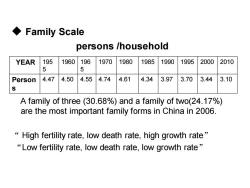
◆Family Scale persons /household YEAR 195 1960 196 1970 1980 1985 1990 1995 2000 2010 5 5 Person 4.47 4.50 4.55 4.74 4.61 4.34 3.97 3.70 3.44 3.10 6 A family of three(30.68%)and a family of two(24.17%) are the most important family forms in China in 2006. "High fertility rate,low death rate,high growth rate" "Low fertility rate,low death rate,low growth rate
◆ Family Scale persons /household A family of three (30.68%) and a family of two(24.17%) are the most important family forms in China in 2006. “ High fertility rate, low death rate, high growth rate” “Low fertility rate, low death rate, low growth rate” YEAR 195 5 1960 196 5 1970 1980 1985 1990 1995 2000 2010 Person s 4.47 4.50 4.55 4.74 4.61 4.34 3.97 3.70 3.44 3.10
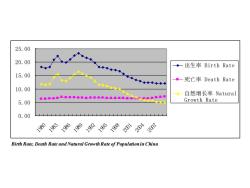
25.00 20.00 ◆-出生率Birth Rate 15.00 -死亡率Death Rate 10.00 自然增长率Natural 5.00 Growth Rate 0.00 Birth Rate,Death Rate and Natural Growth Rate of Population in China
Birth Rate, Death Rate and Natural Growth Rate of Population in China 0.00 5.00 10.00 15.00 20.00 25.00 1980 1983 1986 1989 1992 1995 1998 2001 2004 2007 出生率 Birth Rate 死亡率 Death Rate 自然增长率 Natural Growth Rate
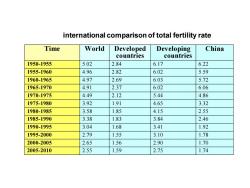
international comparison of total fertility rate Time World Developed Developing China countries countries 1950-1955 5.02 2.84 6.17 6.22 1955-1960 4.96 2.82 6.02 5.59 1960-1965 4.97 2.69 6.03 5.72 1965-1970 4.91 2.37 6.02 6.06 1970-1975 4.49 2.12 5.44 4.86 1975-1980 3.92 1.91 4.65 3.32 1980-1985 3.58 1.85 4.15 2.55 1985-1990 3.38 1.83 3.84 2.46 1990-1995 3.04 1.68 3.41 1.92 1995-2000 2.79 1.55 3.10 1.78 2000-2005 2.65 1.56 2.90 1.70 2005-2010 2.55 1.59 2.75 1.74
international comparison of total fertility rate Time World Developed countries Developing countries China 1950-1955 5.02 2.84 6.17 6.22 1955-1960 4.96 2.82 6.02 5.59 1960-1965 4.97 2.69 6.03 5.72 1965-1970 4.91 2.37 6.02 6.06 1970-1975 4.49 2.12 5.44 4.86 1975-1980 3.92 1.91 4.65 3.32 1980-1985 3.58 1.85 4.15 2.55 1985-1990 3.38 1.83 3.84 2.46 1990-1995 3.04 1.68 3.41 1.92 1995-2000 2.79 1.55 3.10 1.78 2000-2005 2.65 1.56 2.90 1.70 2005-2010 2.55 1.59 2.75 1.74
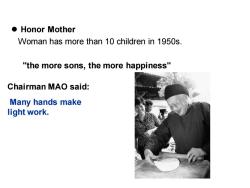
●Honor Mother Woman has more than 10 children in 1950s. "the more sons,the more happiness" Chairman MAO said: Many hands make light work
⚫ Honor Mother Woman has more than 10 children in 1950s. "the more sons, the more happiness" Chairman MAO said: Many hands make light work
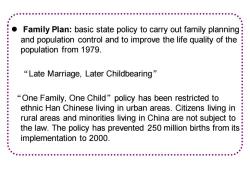
● Family Plan:basic state policy to carry out family planning: and population control and to improve the life quality of the population from 1979. “Late Marriage,Later Childbearing” ●: "One Family,One Child"policy has been restricted to ethnic Han Chinese living in urban areas.Citizens living in : ! rural areas and minorities living in China are not subject to the law.The policy has prevented 250 million births from its: implementation to 2000
⚫ Family Plan: basic state policy to carry out family planning and population control and to improve the life quality of the population from 1979. “Late Marriage, Later Childbearing” “One Family, One Child”policy has been restricted to ethnic Han Chinese living in urban areas. Citizens living in rural areas and minorities living in China are not subject to the law. The policy has prevented 250 million births from its implementation to 2000
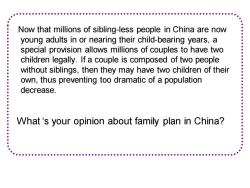
Now that millions of sibling-less people in China are now young adults in or nearing their child-bearing years,a special provision allows millions of couples to have two ● children legally.If a couple is composed of two people without siblings,then they may have two children of their own,thus preventing too dramatic of a population decrease. What's your opinion about family plan in China?
Now that millions of sibling-less people in China are now young adults in or nearing their child-bearing years, a special provision allows millions of couples to have two children legally. If a couple is composed of two people without siblings, then they may have two children of their own, thus preventing too dramatic of a population decrease. What ‘s your opinion about family plan in China?
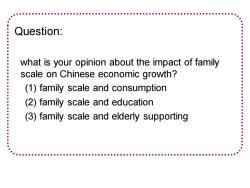
Question: ● what is your opinion about the impact of family scale on Chinese economic growth? (1)family scale and consumption (2)family scale and education (3)family scale and elderly supporting
Question: what is your opinion about the impact of family scale on Chinese economic growth? (1) family scale and consumption (2) family scale and education (3) family scale and elderly supporting
按次数下载不扣除下载券;
注册用户24小时内重复下载只扣除一次;
顺序:VIP每日次数-->可用次数-->下载券;
- 同济大学:《中国社会经济》课程教学资源(PPT课件讲稿)The Transition of Chinese Marriage and Family System.ppt
- 同济大学:《中国社会经济》课程教学资源(PPT课件讲稿)Education Development in China.ppt
- 同济大学:《中国社会经济》课程教学资源(PPT课件讲稿)China’s Socio-Economic Development——Understanding A Development Miracle - China.ppt
- 暨南大学:经济与社会研究院政策简报——粤港澳大湾区发展规划建议(2018年4月).pdf
- 运城学院:《日本社会与文化》课程教学资源(习题,打印版)日本政治練習問題.pdf
- 运城学院:《日本社会与文化》课程教学资源(习题,打印版)日本国土3練習問題.pdf
- 运城学院:《日本社会与文化》课程教学资源(习题,打印版)日本国土2練習問題.pdf
- 运城学院:《日本社会与文化》课程教学资源(习题,打印版)日本国土1練習問題.pdf
- 运城学院:《日本社会与文化》课程教学资源(电子教案,打印版)日本政治2.pdf
- 运城学院:《日本社会与文化》课程教学资源(电子教案,打印版)日本政治1.pdf
- 运城学院:《日本社会与文化》课程教学资源(电子教案,打印版)日本国土3.pdf
- 运城学院:《日本社会与文化》课程教学资源(电子教案,打印版)日本国土2.pdf
- 运城学院:《日本社会与文化》课程教学资源(电子教案,打印版)日本国土1.pdf
- 运城学院:《日本社会与文化》课程教学资源(教学大纲,负责人:左莉娜,打印版).pdf
- 天津开放大学:《社会保障学》课程教学资源(学习资料)社会保障与社会工作.doc
- 天津开放大学:《社会保障学》课程教学资源(学习资料)课程资源.doc
- 天津开放大学:《社会保障学》课程教学资源(学习资料)课程教学大纲.doc
- 天津开放大学:《社会保障学》课程教学资源(学习资料)补考复习.doc
- 天津开放大学:《社会保障学》课程教学资源(学习资料)考核说明.doc
- 天津开放大学:《社会保障学》课程教学资源(学习资料)第四章辅导.doc
- 同济大学:《中国社会经济》课程教学资源(PPT课件讲稿)Financial System in China.ppt
- 《大学图书馆学报》:大学图书馆现代化指南针报告(北京大学).pdf
- 北方工业大学:电子信息工程专业《军事技能》课程教学大纲.pdf
- 北方工业大学:电子信息工程专业《军事理论》课程教学大纲.pdf
- 北方工业大学:计算机科学与技术专业《学术与工程实践》课程教学大纲(创新实验班).pdf
- 北方工业大学:城乡规划《城市社会学》课程教学大纲.pdf
- 北方工业大学:城乡规划《文化遗产保护概论》课程教学大纲.pdf
- 华南师范大学:《中国古代婚姻史》课程教学资源(教学大纲)Acient marriage History of China.doc
- 华南师范大学:《中国古代婚姻史》课程教学资源(PPT课件讲稿,共六章).pptx
- 华南师范大学:《旅游文化学》课程教学资源(课件讲稿)第一讲 导论(主讲:解佳).pdf
- 《旅游文化学》课程教学资源(文献资料)《旅游者:休闲阶层的新理论》与现代性的民族志者:Dean MacCannell访谈录.pdf
- 华南师范大学:《旅游文化学》课程教学资源(课件讲稿)第二讲 旅游与认同(一).pdf
- 华南师范大学:《旅游文化学》课程教学资源(课件讲稿)第二讲 旅游与认同(二).pdf
- 华南师范大学:《旅游文化学》课程教学资源(课件讲稿)第三讲 旅游与地方.pdf
- 华南师范大学:《旅游文化学》课程教学资源(课件讲稿)第四讲 旅游与历史(文明).pdf
- 华南师范大学:《旅游文化学》课程教学资源(课件讲稿)美食与旅游(饮食与旅游).pdf
- 华南师范大学:《旅游文化学》课程教学资源(课件讲稿)互联网新媒体与旅游(影视与旅游).pdf
- 华南师范大学:《旅游文化学》课程教学资源(课件讲稿)文学与旅游.pdf
- 华南师范大学:《旅游文化学》课程教学资源(课件讲稿)节庆与旅游.pdf
- 广东财经大学:文化旅游与地理学院《环境科学概论》课程教学大纲.doc
